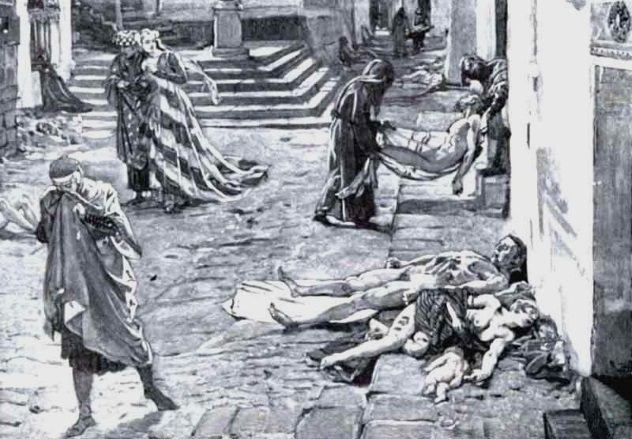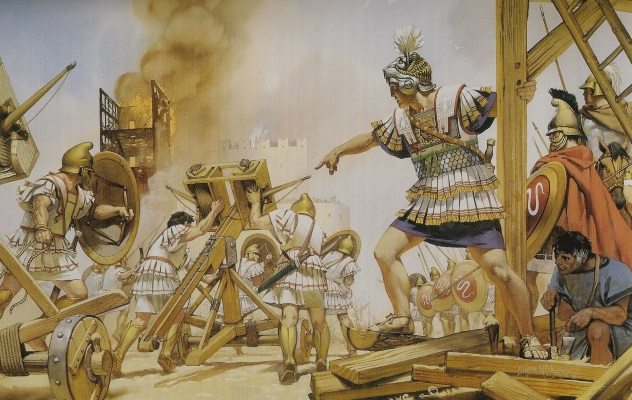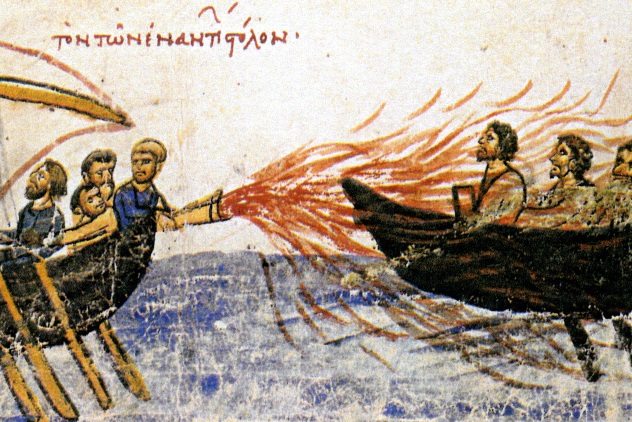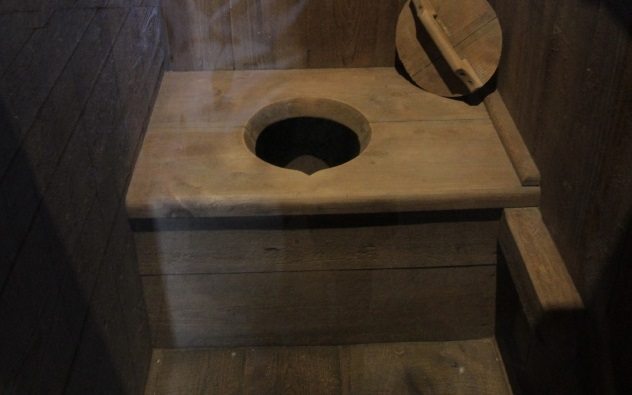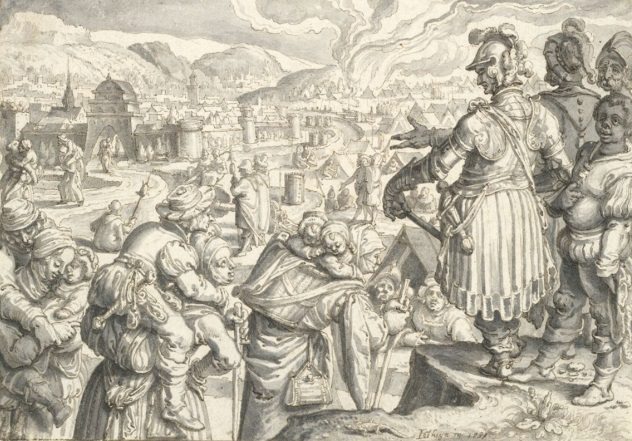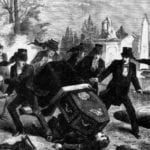In order to break into a city or castle, or to stop besiegers from getting in, humans have poured all their ingenuity into creating a wide variety of weapons. And what’s a deadly siege weapon without an equally diabolical strategy for its use? Here are ten inventive, and frankly bizarre, siege weapons and tactics from history.
10 Pigs
King John is commonly regarded as the worst king in English history. His inability to get along with his nobles led to them rising in rebellion several times. After one of these revolts, they forced the king to agree to a charter of rights, Magna Carta, that is still celebrated as a foundation of English civil rights. But John being John, immediately after agreeing to Magna Carta, he changed his mind and had it declared invalid. The barons rose in rebellion again. In the First Barons’ War, one of the castles held against John was in the city of Rochester. The king tried many ways to take the castle: diplomancy, bombardment, and bribery. He managed to capture the outer yard of the castle, but the rebels in the defensive keep would not yield. So the king turned to pigs to save his bacon. John set his engineers to digging beneath the walls of the keep. When the tunnel was ready, he ordered that “forty of the fattest pigs, the sort least good for eating” be used to burn the support beams of the tunnel.[1] The fire was so intense that the tunnel collapsed and took part of the tower above with it. The rebels held out a while longer but were eventually starved into surrender.
9 Dead Bodies
When you are sitting outside of an enemy’s walls, and your catapults are useless against them, it must be dispiriting. An army camp in the past was an unhealthy place to be, and epidemics could easily devastate a besieging force. When the city of Caffa in Crimea was being attacked by the Mongols in 1346, they found more effective things to launch over the walls than stones. The Black Death had not yet ravaged Europe, but the invading Mongol army brought the disease with them. Instead of retreating and tending to their dying, they put the corpses filling their camp to good use. The bodies were put into catapults and hurled over the walls in hopes that “the intolerable stench would kill everyone inside.”[2] “Mountains of dead” were catapulted, but it was not the smell which was deadly—the plague came in with the rotting corpses. Caffa held against the siege, but it is thought that ships fleeing the city may have helped spread the plague into Europe. Use of biological weapons was also considered by those under siege. In the 17th century, as the siege of Candia dragged on into its 21st year, the inhabitants of the city came up with a plan to make a poisonous liquid to infect the army outside. It would be the essence of plague distilled from the spleens and sores of plague victims. As far as we know, this plan was never used.
8 Heat Rays
When the Romans attempted to capture the Greek city of Syracuse, they faced not only the strong-willed resistance of the inhabitants but also the genius of Archimedes. The mathematician and inventor is said to have created weapons that could lift the Roman ships attacking the harbor clean out of the water before dropping and sinking them. But he is also supposed to have created a method of burning the ships before they even got close. Using mirrors, or polished shields according to some historians, Archimedes directed the light of the Sun onto the ships. The heat is supposed to have ignited the tarred wood of the vessels’ hulls and destroyed them. Some dismiss the idea out of hand, but several attempts to recreate versions of the heat ray have shown that it is possible to set fire to ships in this way.[3] Even if they did not burn the Roman fleet like this, then all those dazzling mirrors would have certainly distracted and blinded the sailors on board.
7 Rocket Cats
Franz Helm was an artillery master in 17th-century Germany, and he literally wrote the book on siege weapons. In one text, he described how you could use a cat to destroy your enemy: Create a small sack like a fire-arrow. If you would like to get at a town or castle, seek to obtain a cat from that place. And bind the sack to the back of the cat, ignite it, let it glow well and thereafter let the cat go, so it runs to the nearest castle or town, and out of fear it thinks to hide itself where it ends up in barn hay or straw it will be ignited.[4] What caught the eye of most researchers were the illustrations that went along with this plan—they make it look as if the cat will be propelled over the walls with a rocket. While it is thought that fire or rocket cats were probably never used in battle, there are records of fire pigs. When the city of Megara was besieged, those inside drove off the elephants outside by smearing pigs in oil and setting them on fire before releasing them from the city.
6 Sand
In any movie about a medieval siege, there will be a scene where defenders are shown heating water or oil to pour down on besiegers as they attempt to scale the walls. But if water or oil was too valuable to waste due to food shortages, other hot things could be dropped from the walls. At the siege of Caen in 1346, Sir Edward Springhouse was knocked off a ladder, and the defenders threw burning hay down on him, roasting him in his armor. Other people under siege have had to get even more creative. When Alexander the Great was attacking the city of Tyre, his men faced something even worse than scalding oil. The defenders of the city took the fine sand of the local area and heated it until it glowed red-hot.[5] This was poured down on the attackers. The fine sand would find its way into any piece of armor and lodge there. Men were driven wild with pain and would strip off their armor, leaving themselves to be picked off by archers on the walls. The sand could also be carried by the wind to the enemy ships and ignite their sails.
5 Greek Fire
Greek fire was a weapon that inspired terror for hundreds of years. It was a liquid that would burst into flame on contact with water and would burn anything it touched. It could be launched from catapults at enemy ships and siege weapons or sprayed over a wide area. No one knows the exact recipe for Greek fire, but it is thought to have contained caustic chemicals, pitch, and resin. The only ways to extinguish Greek fire were said to be sand, salt, or urine. One crusader who faced Greek fire thought the only defense was to fall on your knees and pray for deliverance. As well as being used in the defense of cities, there was also a hand-operated Greek fire weapon called a cheirosiphon that could be used to attack a city.[6] The cheirosiphon was placed on a siege tower that would be wheeled up to the city walls, and the device would shoot a stream of burning Greek fire onto the defenders and buildings inside.
4 Toilets
Most people take the ease of modern plumbing for granted. In the Middle Ages, however, a toilet in a castle could simply be a board projecting over the walls with a hole cut in it that allowed waste to fall below. While you might think that this is going to be about dropping dung on besiegers, toilets could, in fact, be a way for an enemy to get inside. Chateau Gaillard was built by Richard the Lionheart and was supposed to be impregnable. But it was captured less than ten years after it was built. King Philip II of France captured the outer parts of the castle but could not take the inner keep. One of his men saw that a castle toilet, or garderobe, might offer the way in they were looking for. A soldier was sent up the narrow, feces-spattered gap that led up to the toilet. He crawled up, opened a window into the castle chapel, and let the French soldiers take the impregnable castle.[7]
3 Exploding Mill Wheel
In 1552, Ottoman forces laid siege to the Castle of Eger in Hungary. The castle was in a good defensive position, as it commanded a hill which gave the castle guns an advantage over enemies beneath. The tens of thousands of Ottoman troops heavily outnumbered the defenders, however, and were able to keep the castle under almost constant bombardment. The outer walls of the castle began to crumble under the fire, and the defenders’ cannons could not harm the besiegers. Inside the castle, a man named Gergely Bornemissza developed weapons that could reach the attackers. He took the mill wheels, the heavy stones used to crush grain into flour, and stuffed them with gunpowder.[8] Because the castle of Eger was at the top of a hill, these explosive millstones were able to pick up a huge amount of speed as they rolled into the enemy camp and exploded, scattering burning wood and shards of stone into the Ottomans.
2 Piggybacks
In the 12th century, Germany was a patchwork of small principalities loosely held together in the Holy Roman Empire. It was not unusual for states to go to war with one another. In 1140, Conrad III went to war with the Duke of Welf and surrounded the city of Weinsberg. For a long time, the citizens held out. Conrad III told the inhabitants that unless they surrendered to his forces, he would burn the city to the ground and kill everyone inside. When the city did not yield, Conrad was determined to follow through with his threats. Eventually, starved, the citizens of Weinsberg had to give in. Conrad ordered everyone to be gathered in one place to submit and face death. The men of the city, so they said, were willing to die, but they begged for one favor—that their women be allowed to go free. Being a chivalrous man, Conrad gave the women permission to leave the city with whatever they could carry. When the time came for the women to leave, the besieging army was startled to see them walking bent-backed out of the city with their menfolk on their backs.[9] Some in the king’s army thought this was a shameful trick, but the king is said to have laughed and allowed the women and the men to go free.
1 Bees
The benefit of a wall is that you can hide behind it if the enemy throws something at you, and you can also use its height to drop things down on them. Besieging armies are not stupid, however, and will try to avoid giving you the chance to hit them by either digging underground or using shields to keep themselves safe. When the Vikings attacked Chester in the tenth century, they used wooden coverings called hurdles to keep the defenders’ thrown weapons off them as they attempted to destroy the walls. The inhabitants got creative. First, they took all the beer in the city and boiled it in cauldrons before pouring it down on the Vikings. The wood had staved off stones, but the beer found its way through and burned the attackers “so that their skin peeled off.” The Vikings responded by covering their hurdles in animal hides so that the boiling liquid ran off to the sides. But the defenders had one more trick up their sleeves. They took the beehives in the city and hurled them down on the Vikings. Understandably upset by this treatment, the bees set about stinging the Vikings.[10] The Vikings gave up their efforts and abandoned the siege.

